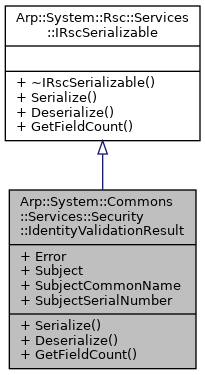Represents the result of the validation of a device identity. More...
#include <IdentityValidationResult.hpp>

Public Member Functions | |
| void | Serialize (RscWriter &writer) const override |
| Serializes the datatype. All fields of the datatype have to be serialized in use of RscWriter. More... | |
| void | Deserialize (RscReader &reader) override |
| Deserializes the datatype. All fields of the datatype have to be deserialized in use of RscReader. More... | |
 Public Member Functions inherited from Arp::System::Rsc::Services::IRscSerializable Public Member Functions inherited from Arp::System::Rsc::Services::IRscSerializable | |
| virtual | ~IRscSerializable ()=default |
| default destructor More... | |
Static Public Member Functions | |
| static constexpr size_t | GetFieldCount (void) |
 Static Public Member Functions inherited from Arp::System::Rsc::Services::IRscSerializable Static Public Member Functions inherited from Arp::System::Rsc::Services::IRscSerializable | |
| static size_t | GetFieldCount (void) |
| Returns the count of fields of the struct type More... | |
Public Attributes | |
| IdentityValidationError | Error = static_cast<IdentityValidationError>(0) |
| The numeric indication about success or failure of the validation. More... | |
| RscString< 512 > | Subject |
| The subject field from the certificate of the identity represented as text conforming to RFC 2253. More... | |
| RscString< 80 > | SubjectCommonName |
| The CommonName component of the subject field from the certificate of the identity. More... | |
| RscString< 80 > | SubjectSerialNumber |
| The SerialNumbner component of the subject field from the certificate of the identity. More... | |
Detailed Description
Represents the result of the validation of a device identity.
Member Function Documentation
◆ Deserialize()
|
inlineoverridevirtual |
Deserializes the datatype. All fields of the datatype have to be deserialized in use of RscReader.
- Parameters
-
reader Reference to RscReader.
Implements Arp::System::Rsc::Services::IRscSerializable.
◆ Serialize()
|
inlineoverridevirtual |
Serializes the datatype. All fields of the datatype have to be serialized in use of RscWriter.
- Parameters
-
writer Reference to RscWriter
Implements Arp::System::Rsc::Services::IRscSerializable.
Member Data Documentation
◆ Error
| IdentityValidationError Arp::System::Commons::Services::Security::IdentityValidationResult::Error = static_cast<IdentityValidationError>(0) |
The numeric indication about success or failure of the validation.
◆ Subject
| RscString<512> Arp::System::Commons::Services::Security::IdentityValidationResult::Subject |
The subject field from the certificate of the identity represented as text conforming to RFC 2253.
This is valid only if Arp.System.Commons.Services.Security.IdentityValidationResult.Error is Arp.System.Commons.Services.Security.IdentityValidationError.None.
◆ SubjectCommonName
| RscString<80> Arp::System::Commons::Services::Security::IdentityValidationResult::SubjectCommonName |
The CommonName component of the subject field from the certificate of the identity.
This is valid only if Arp.System.Commons.Services.Security.IdentityValidationResult.Error is Arp.System.Commons.Services.Security.IdentityValidationError.None. A certificate does not need to have the component. Then this string is empty. But by convention certificates usually have such a component.
◆ SubjectSerialNumber
| RscString<80> Arp::System::Commons::Services::Security::IdentityValidationResult::SubjectSerialNumber |
The SerialNumbner component of the subject field from the certificate of the identity.
This is valid only if Arp.System.Commons.Services.Security.IdentityValidationResult.Error is Arp.System.Commons.Services.Security.IdentityValidationError.None. A certificate does not need to have the component. Then this string is empty. Please note that this serial number is NOT the serial number of the certificate. But it is the serial number component from the subject of the certificate. Only very few certificates have this component in the subject. Some device vendors put the serial number of the device into the subject this way. PHOENIX CONTACT does so.
The documentation for this class was generated from the following file:
- Arp/System/Commons/Services/Security/IdentityValidationResult.hpp